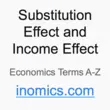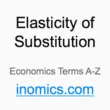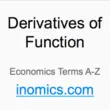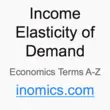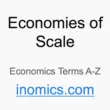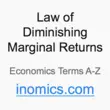-
- Economics Terms A-Z
- Posted 1 year ago
Le marché du travail
en it es de fr
-
- Economics Terms A-Z
- Posted 1 year ago
Les marchés des facteurs
en it es de fr
-
- Economics Terms A-Z
- Posted 2 years ago
Normal Goods & Luxury Goods

-
- Economics Terms A-Z
- Posted 2 years ago
Inferior Goods & Giffen Goods

-
- How the Crisis is Opening Opportunities for the Profession
- Posted 3 years ago
COVID-19 and the Economists’ Redemption
The following article first appeared in the INOMICS Handbook 2021. Download the INOMICS Handbook On a visit to the London School of Economics in November 2008, the Queen asked her hosts why no one had seen the financial crisis coming. It took the professors nine months to come up with an excuse, put forth in a letter in July 2009:

-
- Economics Terms A-Z
- Posted 3 years ago
Effet de substitution et effet de revenu
en it es de fr
-
- Economics Terms A-Z
- Posted 5 years ago
Elasticité de substitution
en it es de fr
-
- Economics Terms A-Z
- Posted 5 years ago
Les externalités
en it es de fr
-
- Economics Term
- Posted 5 years ago
Les dérivés de fonction
en it es de fr
-
- Online Education
- Posted 5 years ago
From University Campus to Remote Education: How Steep is the Learning Curve?
Universities around the world are currently experiencing a crash course in online education. The coronavirus pandemic has shaken the sector in a big way, leaving professors and students struggling to complete the academic year off campus and having to prepare for the next one under very uncertain circumstances. Although online learning has been around for at least two decades, adapting all courses to remote forms of education is proving a steep learning curve for most institutions. Applying a basic economic principle and considering some of the evidence on online versus traditional teaching methods can help to assess the likely effects of recent campus closures on student learning outcomes and to see how course provision and programme design may develop in the longer term.

-
- Economics Terms A-Z
- Posted 5 years ago
La Boîte d'Edgeworth
en it es de fr
-
- Economics Terms A-Z
- Posted 5 years ago
La fonction de production de Cobb-Douglas
en it es de fr
-
- Economics Terms A-Z
- Posted 5 years ago
Maximisation de l'utilité
en it es fr
-
- Economics Terms A-Z
- Posted 5 years ago
Rareté et choix
en it es de fr
-
- Economics Term
- Posted 5 years ago
Les barrières commerciales
en it es fr
-
- Economics Terms A-Z
- Posted 5 years ago
Elasticité de l'offre par rapport au prix
en it es de fr
-
- Economics Terms A-Z
- Posted 5 years ago
L’Oligopole
en it es de fr
-
- Economics Term
- Posted 5 years ago
Elasticité de la demande par rapport au prix
en it es de fr
-
- Economics Terms A-Z
- Posted 5 years ago
L’élasticité de la demande par rapport au revenu
en it es de fr
-
- Economics terms A-Z
- Posted 5 years ago
Les économies d'échelle
en it es de fr
-
- Economics Terms A-Z
- Posted 5 years ago
La sélection adverse
en it es de fr
-
- Economics Term
- Posted 5 years ago
Ceteris Paribus
en it es de fr
-
- Economics Terms A-Z
- Posted 5 years ago
Information Asymétrique
en it es de fr
-
- Economics Terms A-Z
- Posted 5 years ago
La loi des rendements marginaux décroissants
en it es de fr
-
- Economics Term
- Posted 5 years ago
La perte sèche
en it es de fr
Pagination







